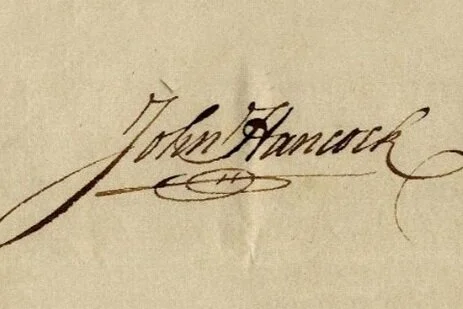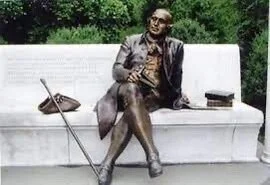American Sources
Division in America - Federalist #10It may surprise readers to learn that the founders of our republic were concerned about the very modern problem of excessive divisiveness developing in the country. In Federalist #10 written by James Madison, he addresses the ills that can come to our country if it were to become too divided due to partisan bickering and the undue influence of interest groups and the economic interests of the few. Leading up to the ratification of the constitution, John Jay, Alexander Hamilton, and James Madison wrote 85 articles and essays on various questions which might arise in any constitutional republic to consider before its ratification. They were distributed in various New York newspapers under the pseudonym “Publius,” which Alexander Hamilton suggested- a reference to the Roman consul, Publius Valerius Publicola. They were distributed in order to urge New Yorkers to vote for ratification. ** Perhaps the most well known of the Federalist Papers is Federalist 10 in which Madison calls lobbying and interest groups “factions.” He discusses just how these factions can benefit, divide and although they do arise organically; how they can be problematic for the health of the community. The delicate reconciliation and balance between “factions,” as Madison called them, and the rights of individuals and the well being of the community were problematic and central issues even in 1788 while states considered whether or not to adopt the constitution. Clearly, given today's divisiveness, this challenge has not changed significantly since ratification of the constitution. (Federalist #10) .The Federalist Papers and Federalist #10How does Federalist #10 suggest ratification of the Constitution can help to resolve political, social and economic interests which can cause deep division among society? John Jay, James Madison and Alexander Hamilton were Federalists. They believed in a strong executive and central government and the constitution reflects this. They argued that the checks and balances of the three branches of government present in the constitution would be sufficient to balance the rights of the government, the states and the citizenry. Many of the Federalists therefore, had misgivings about leaning too much on the power of the states and individuals over the central government. On the other hand, the anti-federalists believed that the Bill of Rights which placed more authority on the states and individuals, should be preferred. The Bill of Rights had their origin in the English the English Bill of Rights of 1689 and Virginia’s Declaration of Rights, drafted by George Mason in 1776. George Mason, a native Virginian, was a lifelong champion of individual liberties. The ten amendments, known as the Bill of Rights, were designed to protect the basic rights of the early citizens and were to guarantee the freedom of speech, press, assembly, and free exercise of religion. In addition, they included the right to fair legal procedures, to bear arms; and that powers not delegated to the federal government were reserved for the states and the citizens. For many support of the Bill of Rights ensured that no other foreign power, like a King George or domestic power tyranny could take control over the colonies. Although there are many places to read and examine founding documents; my very favorite source for original and founding documents from the 18th Century is The Avalon Project at Yale University.The Constitution of the United StatesArticle I – The Legislative Branch. The principal mission of the legislative body is to make laws. It is split into two different chambers – the House of Representatives and the Senate. Congress is a legislative body that holds the power to draft and pass legislation, borrow money for the nation, declare war and raise a military. It also has the power to check and balance the other two federal branches.Article II – The Executive Branch. This branch of the government manages the day-to-day operations of government through various federal departments and agencies, such as the Department of Treasury. At the head of this branch is the nationally elected President of the United States.The president swears an oath to ‘faithfully execute’ the responsibilities as president and to ‘preserve, protect and defend the Constitution of the United States’. Its powers include making treaties with other nations, appointing federal judges, department heads and Ambassadors, and determining how to best run the country and run military operations.Article III – The Judicial Branch. Article III outlines the powers of the federal court system. Determines that the court of last resort is the US Supreme Court and that the US Congress has the power to determine the size and scope of those courts below it. All judges are appointed for life unless they resign due to bad behaviour. Those facing charges are to be tried and judged by a jury of their peers.Article IV – The States. This article defines the relationship between the states and the federal government. The federal government guarantees a republican form of government in each state, protects the nation and the people from foreign or domestic violence, and determines how new states can join the Union. It also suggests that all the states are equal to each other and should respect each other’s laws and the judicial decisions made by other state court systems.Article V Amendment. Future generations can amend the Constitution if the society so requires it. Both the states and Congress have the power to initiate the amendment process.Article VI – Debts, Supremacy, Oaths. Article VI determines that the US Constitution, and all laws made from it are the ‘supreme Law of the Land’, and all officials, whether members of the state legislatures, Congress, judiciary or the Executive have to swear an oath to the Constitution.Article VII – Ratification. This article details all those people who signed the Constitution, representing the original 13 states.*John Hancock signed his name so large so that “…someone can read my name without spectacles.”
George Mason anti-Federalist
Ratifying the Constitution
Bill of RightsI - Freedom of Speech, Press, Religion and PetitionII - Right to keep and bear armsIII - Conditions for quarters of soldiersIV - Right of search and seizure regulatedV - Provisons concerning prosecutionVI - Right to a speedy trial, witnesses, etc.VII - Right to a trial by juryVIII - Excessive bail, cruel punishmentIX - Rule of construction of ConstitutionX - Rights of the States under Constitution Compromise:As we now know, a compromise was reached allowing adoption of the Constitution in 1787 by members of the Constitutional Congress, that spells out the division of powers and specifies federal and executive powers, as long as the Bill of Rights was sure to be adopted. It was in 1779, after it had been ratified by three fourths of the extant states. The Constitution and The Bill of Rights ensure the delicate balance between the powers of the central government, the powers of the states and the rights of their inhabitants, the citizenry.John Jay
James Madison
Alexander Hamilton
The Federalist Society and Today’s Supreme CourtThe Federalist Society was formed on the Yale Law School campus in 1982, and soon gained membership at numerous other American law schools. The Society now counts something like 1000 members and is committed to a "textual" understanding of the original constitutional documents. For this reason its adherents call themselves “originalists” or textualists. They believe in interpreting the original documents as close as possible to their original intent and attempt to do this through their interpretation of the language in the original documents. The group’s ultimate goal is to have a conservative majority on the Supreme Court. Amy Conen Barrett and Antonin Scalia have both been active members of the Federalist Society. One of the first active members of the Federalist society in the federal government was Edwin Meese, US Attorney General in the Reagan Administration. The criticism of the liberal “Warren” Court by those who share the Federalist philosophy is that one must understand the constitution as intended (as written) as opposed to what one wants it to be. This has given rise to their criticism of the liberal court that the Court “legislates” as opposed to “interprets.” On the other hand, those who take this opposite view, believe that the text must be interpreted to be relevant to each generation and its exigences. 









